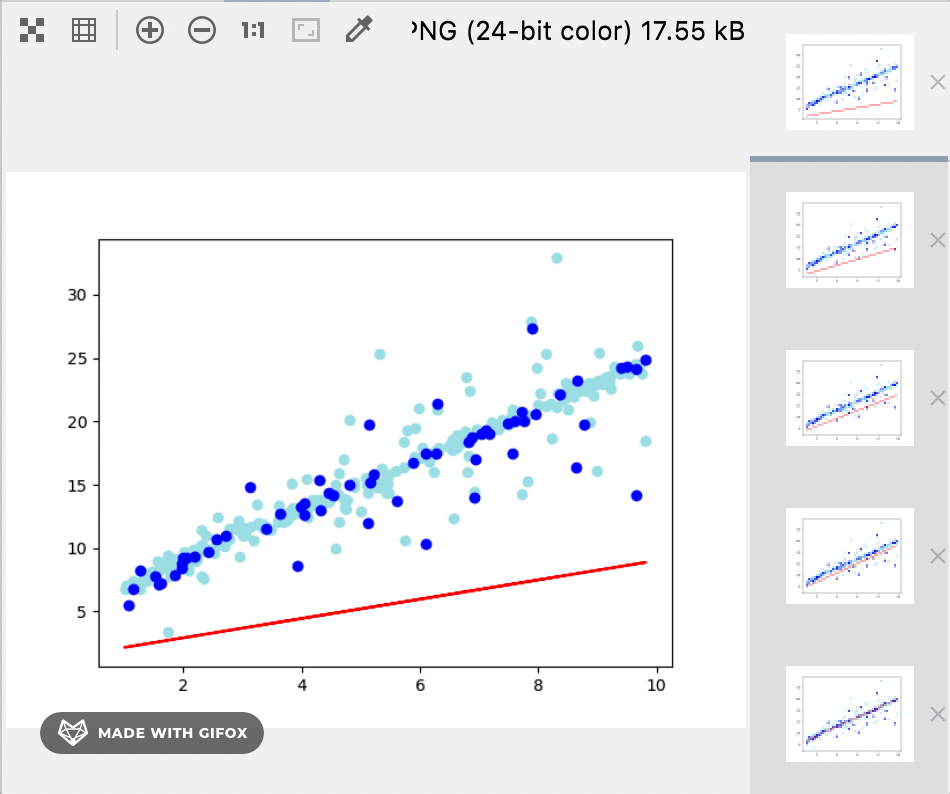tensorflow使用sequential实现简单线性回归
本文目录
sequential介绍
sequential理解为堆叠,通过堆叠许多层,构建出深度神经网络
https://tensorflow.google.cn/api_docs/python/tf/keras/Sequential
获取或生成csv文件
- 生成大致符合
y = 2*x + 5的一组数据,并加入噪声 - 写入文件,需要注意第一次写入和追加写入
import csv
import numpy as np
import matplotlib.pyplot as plt
import os
# 生成x值
x = np.random.randint(1, 101, size=100)
# 生成带有一些噪声的y值,修改scale值增加噪声偏差
y = 2*x + 5 + np.random.normal(scale=0.2, size=len(x))
# 添加额外的20%噪声(生成多次,其中一次加入大噪声)
y += np.random.normal(scale=0.2*np.abs(y), size=len(y))
# 保留2位小数
x = np.round(x, 2)
y = np.round(y, 2)
# 如果data.csv不存在,则创建文件并写入表头
if not os.path.exists('data.csv'):
with open('data.csv', mode='w') as file:
writer = csv.writer(file)
writer.writerow(['x', 'y'])
for i in range(len(x)):
writer.writerow([x[i], y[i]])
# 如果data.csv存在,则使用追加写入模式
else:
with open('data.csv', mode='r') as file:
reader = csv.reader(file)
header = next(reader)
if header != ['x', 'y']:
raise ValueError("The header of data.csv is not correct.")
with open('data.csv', mode='a') as file:
writer = csv.writer(file)
for i in range(len(x)):
writer.writerow([x[i], y[i]])
print("数据已写入data.csv")
plt.scatter(x, y)
plt.show()
分别修改参数,为了拟合的准确性





线性回归实现
1.读取包含线性关系的.csv文件
data = pd.read_csv('./data.csv')
print(data)
2.将数据划分为训练集和测试集
train_data = data.sample(frac=0.8, random_state=0)
test_data = data.drop(train_data.index)
3.顺序模型squential的建立
顺序模型是指网络是一层一层搭建的,前面一层的输出是后一层的输入,采用线性激活的全连接(Dense)层,它实际上封装了输入值x乘以权重w,加上偏置(bias)b,然后进行线性激活以产生输出
model = tf.keras.Sequential()
model.add(tf.keras.layers.Dense(1, input_shape=(1,)))
4.查看模型的结构
model.summary()
5.编译模型
配置的过程, 优化算法方式(梯度下降)、损失函数选择mse即均方误差,Adam优化器的学习速率默认为0.01
model.compile(optimizer='adam', loss='mse')
6.训练模型
记录模型的训练过程 history,如果模型存在,则加载模型继续训练
训练过程是loss函数值降低的过程,即不断逼近最优的a和b参数值的过程,这个过程要训练很多次epoch,epoch是指对所有训练数据训练的次数
if os.path.exists('./model.h5'):
model = tf.keras.models.load_model('./model.h5')
history = model.fit(train_data.x, train_data.y, epochs=1000)
model.save('./model.h5')
7.评估模型
accuracy = model.evaluate(test_data.x, test_data.y)
print("Accuracy: {:.2f}%".format(accuracy * 100))
8.已知数据预测
model.predict(test_data.x)
print(model.predict(test_data.x))
9.随机数据预测
test_predict = model.predict(pd.Series([10, 20])) # 预测的数据为10和20
print(test_predict)
print(pd.DataFrame([(10, 20, 30)]))
10.绘制训练过程的loss
plt.plot(history.history['loss'])
plt.title('Model Loss')
plt.ylabel('Loss')
plt.xlabel('Epoch')
plt.show()
11 查看权重和偏移
res = model.layers[0].get_weights()
w = res[0][0][0]
b = res[1][0]
print(w)
print(b)
12 将训练集,测试集和最后的训练结果绘制到图上
plt.plot(data.x, w * data.x + b, color='red')
plt.scatter(train_data.x, train_data.y, color='powderblue')
plt.scatter(test_data.x, test_data.y, color='blue')
plt.show()
训练过程和结果
// step 8
[[25.062683]
[45.056755]]
// step 9
0 1 2
0 10 20 30
// step 11
1.9994073
5.06861
























 2557
2557

 被折叠的 条评论
为什么被折叠?
被折叠的 条评论
为什么被折叠?










